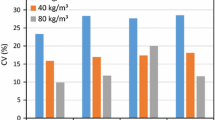Abstract
High variability in experimental estimates of post-crack performance for fibre reinforced concrete (FRC) remains a problem that compromises progress toward a comprehensive understanding of this material and reduces the realisable performance of FRC in design. In recent years, the possible influence of many factors on variability in performance has been studied, and as a result, the number of fibres bridging and supporting tension across the crack plane has been recognised as contributing to variability in commonly used flexural performance tests. Unfortunately, no commonly used post-crack performance testing standard for FRC requires the number of fibres that protrude from the surface of crack faces to be counted. This leads to a paucity of data that obscures the significant role this parameter plays in performance variability, particularly when very high levels of performance variability are encountered. The present paper summarises the results of numerous investigations in which direct fibre counting has been conducted as part of FRC assessment, thereby providing a large body of data to facilitate an empirical means of quantifying the influence of fibre count on post-crack performance variability.






Similar content being viewed by others
References
ASTM C1550 (2012) Standard Test Method for Flexural Toughness of Fiber Reinforced Concrete (Using Centrally Loaded Round Panel). ASTM International, West Conshohocken
ASTM C1609/C1609M (2012) Standard Test Method for Flexural Toughness of Fiber-Reinforced Concrete (Using Beam with Third-point Loading). ASTM International, West Conshohocken
BS-EN 14651 (2006) Test method for metallic fibre concrete—measuring the flexural tensile strength (limit of proportionality (LOP), residual). British Standards, London
BS-EN 14488 Part 3 (2006) Testing sprayed concrete—flexural strengths (first peak, ultimate and residual) of fibre reinforced beam specimens. British Standards, London
Barr BIG, Lee MK, de Place Hansen EJ, Dupont D, Erdem E, Schaerlaekens S, Schnütgen B, Stang H, Vandewalle L (2003) Round-robin analysis of the RILEM TC 162-TDF beam-bending test: part 1—test method evaluation. Mater Struct 36(9):609–620
Parmentier B, Vandewalle L, Van Rickstal F (2008) Evaluation of the scatter in post-peak behaviour of fibre reinforced concrete in bending: a step towards reliability. In: BEFIB 2008: seventh international conference on fibre reinforced concrete, pp 133–143
Bernard ES (2002) Correlations in the behaviour of fibre reinforced shotcrete beam and panel specimens. Mater Struct 35:156–164
Cavalaro SHP, Aguado A (2015) Intrinsic scatter of FRC: an alternative philosophy to estimate characteristic values. Mater Struct RILEM 48:3537–3555
Gossla U (2000) Bearing behaviour and safety of steel reinforced structural elements (Tragverhalten und Sicherheit betonstahlbewehrter Baustahlfaserbetonteile). In: Bulletin 501, German commission for building with reinforced concrete. DAfStb, Beuth Verlag. ISBN 3-410-65701-0 (in German)
Hanke SA, Collis A, Bernard ES (2001) The M5 motorway tunnel: an education in quality assurance for fibre reinforced shotcrete. In: Bernard ES (ed) Shotcrete: engineering develop-ments. Swets & Zeitlinger, Lisse
Asche HR, Bernard ES (2004) Shotcrete design and specification for the cross city Tunnel, Sydney. In: Bernard ES (ed) Shotcrete: more engineering developments. Taylor & Francis, London, pp 27–38
Bernard ES, Xu GG, Carino NJ (2010) Influence of the number of replicates in a batch on apparent variability in FRS and FRC performance assessed using ASTM C1550 panels. In: Bernard ES (ed) Shotcrete: elements of a system. Taylor & Francis, London, pp 39–48
Deming WE (1966) Some theory of sampling. Dover Publications, New York
ASTM International (2002) Manual on presentation of data and control chart Analysis, MNL7A, West Conshohocken, PA
Bernard ES, Xu GG (2017) Estimation of population standard deviation for post-crack performance of fiber reinforced concrete. Adv Civ Eng Mater 6(1):68–82. doi:10.1520/ACEM20160055
Vandewalle L, Rickstal FV, Heirman G, Parmentier B (2008) On the round panela and 3-point bending tests. In: Seventh international RILEM symposium on fibre reinforced concrete (BEFIB 2008), Chennai, India, 17–19 September, pp 173–182
Bernard ES (2009) Influence of test machine control method on flexural performance of fiber reinforced concrete beams. J ASTM Int 6(9):1–16
Merretz W, Borgert J, Smith G, Baweja D (2011) Steel fibre reinforced concrete in construction contracts and the 3 mm residual flexural strength beam test. In: 25th biennial conference, Concrete Institute of Australia, Perth, 12–14 October
Barros JAO, Cunha VMCF, Ribeiro AF, Antunes JAB (2005) Post-cracking behavior of steel fibre reinforced concrete. Mater Struct 38:47–56
de la Fuente A, Escariz RC, de Figueiredo AD, Molins C, Aguado A (2012) A new design method for steel fibre reinforced concrete pipes. Constr Build Mater 30:547–555
di Prisco M, Dozio D (2008) Post-tensioned SFRC Beams. In: Seventh international RILEM symposium on fibre reinforced concrete (BEFIB 2008), Chennai, India, 17–19 September, pp 899–909
Bernard ES, Xu GG (2007) A comparison of flexural performance for third-point loaded and centrally-loaded fiber reinforced concrete beams. J ASTM Int 4(3):1–12
Merretz W, Borgert J, Smith G, Bernard ES (2013) Use of 1200 mm diameter round panels for quality control testing of SFRC used in pre-cast tunnel lining segments. In: 13th biennial concrete institute of Australia conference, October, Gold Coast, Australia
Bernard ES (2013) Development of a 1200 mm diameter round panel test for post-crack assessment of fiber reinforced concrete. Adv Civ Eng Mater ASTM Int 2(1):457–471
Bernard ES (2016) Post-crack performance of fiber reinforced concrete and its effect on the first peak cracking load of slabs. Aust J Struct Eng. doi:10.1080/13287982.2016.1228337
Banthia N, Trottier J-F (1994) Concrete reinforced with deformed steel fibers, Part 1: bond-Slip mechanisms. ACI Mater J 91(5):435–446
Laranjeira F, Molins C, Aguado A (2010) Predicting the pullout response of inclined hooked steel fibers. Cem Concr Res 40:1471–1487
Acknowledgements
The authors wish to thank Elasto-Plastic Concrete Pty Ltd for their support of this work, and Joshua Tolhurst for performing all the tests.
Author information
Authors and Affiliations
Corresponding author
Rights and permissions
About this article
Cite this article
Bernard, E.S., Xu, G.G. Influence of fibre count on variability in post-crack performance of fibre reinforced concrete. Mater Struct 50, 169 (2017). https://doi.org/10.1617/s11527-017-1035-5
Received:
Accepted:
Published:
DOI: https://doi.org/10.1617/s11527-017-1035-5




